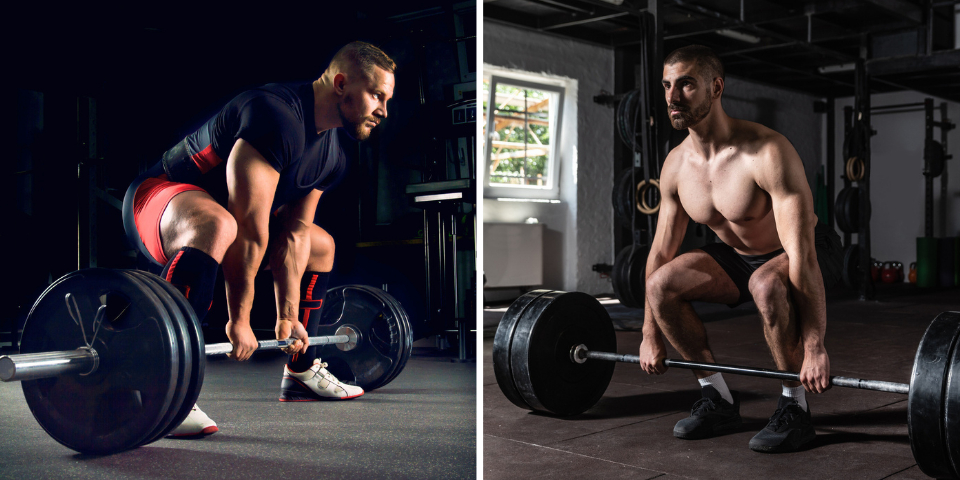[ad_1]
In the health and fitness space, there are some eerie ideological similarities: cardio vs. strength training, plant vs. animal protein, front squat vs. back squat. Of these titanic subjects, however, few can compete with sumo versus the conventional deadlift.
Walk into any weight room (or Internet discussion) and you’re sure to hear sumo vs. conventional deadlift arguments punctuated by the clatter of plates. Sumo is cheating! Conventional dangerous!
The list of complaints against each of these deadlift variations is virtually endless. However, examine the allegations, and you’ll find that these composite movements have more in common than their respective fan bases realize.
Sumo vs Conventional Deadlift: Is One Better Than the Other?
Although there are meaningful biomechanical differences between sumo and conventional deadlifts, according to CSCS personal trainer and fitness coach Brandon Kong, “neither is superior to the other.”
Rather, each movement has its own distinct benefits, and the “correct” deadlift variation is one that works for your goals, makes sense biomechanically, and can be performed both comfortably and confidently, according to Kwong.
What is the difference between sumo and conventional deadlift?
Ultimately, the “best” movement comes down to the lifter’s goals and abilities. “Spend a few months on each type of deadlift, focusing on good technique, and get a feel for what’s more comfortable,” says Kwong.
Testing the sumo vs. conventional deadlift water here can also point out weaknesses in your back or quad muscles, which can help strengthen proper accessory movements.
With that being said, here are some key differences between the two deadlift styles.
Conventional deadlift

- Feet hip-width apart with arms outside.
- According to Kwong, the conventional deadlift has more “sport-specific” applications because it “reflects universal athletic positions.”
- May be an easy lift for those with poor hip mobility.
- This can be a great exercise for those looking to build a strong upper back and spinal erectors.
- The most common form errors: bending the torso too far at the waist, not executing the all-important “hip hinge” correctly (more on that below), not cutting the slack in the arms, losing tension in the posterior chain.
Sumo deadlift

- Feet a few inches wider than hip-width with arms inside.
- The sumo deadlift’s “shorter range of motion means the barbell travels less distance,” according to Kwong, which can make it easier to train frequently with heavier loads.
- A higher one-rep may yield the highest yield.
- May be difficult for those with poor hip mobility.
- The most common form errors: bending the torso too far at the waist, not executing the hip hinge properly, hyperextension of the lumbar spine (lower back) at the top of the lift.
Can you lift more with a sumo deadlift than a conventional deadlift?
“The sumo deadlift’s shorter range of motion causes the weight to travel less distance because of its wider stance,” Kwong says, which should make it easier for most people to move heavy weights repeatedly — in theory.
However, the amount you can lift with either variation probably comes down to your biomechanics, although the one-rep max record (held by Hafthor Bjornsson) in a conventional position sits at 1,104 pounds, while Chris Duffin’s record one-rep max sumo deadlift is around 100. Pounds lighter.
Is any modification good for building strength and muscle?
Both conventional and sumo positions are effective muscle-builders – especially for the glutes, hamstrings and lower back – and should have a place in your training plan. Together, they’ll help you achieve the variety you need to optimize muscle growth.
In terms of strength and athletic build, however, conventional positions are superior. The sumo deadlift is still a great exercise for improving lower-body strength, but the conventional deadlift is a basic movement that should be at the core of your strength training program. It helps you generate more functional strength than its sumo counterpart because it more effectively utilizes the hip hinge, a fundamental movement pattern in functional fitness.
In short, the training adaptations you get from the conventional deadlift have real-world applicability — from sports performance to everyday life.
Which do trainers recommend?

Trainers recommend mastering the conventional deadlift before advancing to its variations. Once you’ve perfected the movement, Kwong says the difference between the two comes down to the people performing them.
“If you’re a powerlifter and the goal is to pull the most weight off the floor, and you’re comfortable with sumo, go for it,” he says. “At the end of the day, it’s about providing maximum stimulation with minimum risk of injury.”
How to perform a conventional deadlift
- Stand with your feet hip-width apart and position the barbell directly over your mid-feet.
- Keeping your back flat and core engaged, push your hips back (think you’re closing a door with your butt) as you bend your knees slightly and grab the barbell with one overhand (palms facing back). (Remember to always keep your butt higher than your knees.) This is the starting position.
- Keeping your core engaged, back flat and the bar close to your body, drive through your heels and lift the bar until your legs are fully extended, squeezing your glutes and driving your hips forward as you do.
- Pause, and then reverse the movement to return to the starting position.
How to perform a sumo deadlift
- Stand with your feet a few inches wider than shoulder-width, shoelaces directly under the barbell and toes pointed slightly outward (roughly a 45 degree angle).
- With your back flat and your arms hanging naturally between your knees, push your hips back (think you’re closing a door with your butt – this is the “hip hinge” mentioned earlier) as you bend your knees slightly and grab the bar in an overhand ( palm facing backwards) grip. (Keep your knees in line with your feet and remember to keep your butt higher than your knees at all times.) This is the starting position.
- Keeping your core engaged, back flat and the bar close to your body, drive through your heels and lift the bar until your legs are fully extended, squeezing your glutes and driving your hips forward as you do.
- Pause, and then slowly reverse the movement to return to the starting position.
[ad_2]
Source link





